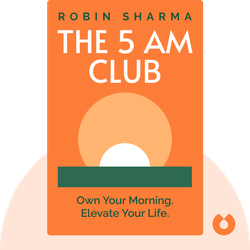Try Blinkist to get the key ideas from 7,000+ bestselling nonfiction titles and podcasts. Listen or read in just 15 minutes.
Start your free trial
Blink 3 of 8 - The 5 AM Club
by Robin Sharma

The History of a Nuclear Catastrophe
Chernobyl by Serhii Plokhy is a historical account of the nuclear disaster that took place in Ukraine in 1986. It explores the political, environmental, and social consequences of the catastrophic event that shook the world.
In 1986, the Chernobyl Nuclear Power Plant in Soviet Ukraine was the third most powerful on Earth.
To accommodate its army of workers, authorities constructed the city of Prypiat two kilometers from the plant. Bustling with a population of 45,000, life in this “nuclear town” was luxurious by Soviet standards: meat and dairy were available in shops, and it boasted two swimming pools and an ice rink. This idyllic scene was shattered after April 26, when a series of explosions tore through Chernobyl’s Unit 4 – home to its fourth nuclear reactor.
To really grasp the scope of this disaster, it’s helpful to understand how nuclear reactors work. First of all, they exist to create heat. This heat vaporizes water into steam, powering turbines to produce electricity. They create heat through a process called fission.
Fission is when the nucleus of an atom splits into smaller components. When fission occurs, energy and tiny subatomic particles called neutrons are released. We can induce fission by forcing a neutron to collide with another atom’s nucleus – but we can’t do this without a supply of neutrons that have already been freed from their original atom.
The nuclei of some atoms – like uranium-235 – are extremely unstable. They naturally want to undergo fission to allow them to split into smaller, more stable parts. This natural fission can start a chain reaction, with freed neutrons colliding with other atoms, splitting them and releasing more neutrons. Packing uranium-235 atoms close together in fuel rods creates just this kind of chain reaction.
But there’s a problem: neutrons travel so fast that they’re unlikely to hit other uranium atoms. To slow them down and thus increase reactivity, nuclear plants use substances like water and graphite.
To control the power of the reaction, nuclear plants also have control rods, made of materials like boron, which absorb neutrons. These are inserted into the reactor’s core and adjusting the depth of the control rods regulates the power of the reaction. Meanwhile, cooling fluid circulates through the reactor itself, moderating its overall temperature.
So, what happened inside Unit 4 on April 26? Well, unbelievably, operators were conducting a safety test on this very system.
If Chernobyl ever experienced a power loss, electricity was still required to pump the cooling fluid into the reactor to stop it from overheating. Diesel generators were on hand for this, but they took 45 seconds to kick in – a dangerous delay. But Chernobyl’s steam turbines didn’t immediately stop after a power loss, so it was possible that their dying rotations would produce enough electricity to bridge the 45-second gap before power was restored. The test aimed to confirm this.



Chernobyl (2018) documents the 1986 nuclear meltdown that shook the Soviet Union. It is an insightful and meticulously researched work of history, drawing from newly opened archives to shed fresh light on the disaster. Piecing together the entire episode, Plokhy takes us from the fateful minutes before the disaster to the cleanup operation and, finally, the disintegration of the USSR.
Chernobyl (2018) by Serhii Plokhy is a gripping account of the 1986 Chernobyl nuclear disaster and its far-reaching consequences. Here's why this book is worth reading:
It's highly addictive to get core insights on personally relevant topics without repetition or triviality. Added to that the apps ability to suggest kindred interests opens up a foundation of knowledge.
Great app. Good selection of book summaries you can read or listen to while commuting. Instead of scrolling through your social media news feed, this is a much better way to spend your spare time in my opinion.
Life changing. The concept of being able to grasp a book's main point in such a short time truly opens multiple opportunities to grow every area of your life at a faster rate.
Great app. Addicting. Perfect for wait times, morning coffee, evening before bed. Extremely well written, thorough, easy to use.
Try Blinkist to get the key ideas from 7,000+ bestselling nonfiction titles and podcasts. Listen or read in just 15 minutes.
Start your free trial
Blink 3 of 8 - The 5 AM Club
by Robin Sharma
What is the main message of Chernobyl?
The main message of Chernobyl is the catastrophic consequences of nuclear power and the importance of understanding the risks involved.
How long does it take to read Chernobyl?
The reading time for Chernobyl varies. However, the Blinkist summary can be read in just 15 minutes.
Is Chernobyl a good book? Is it worth reading?
Chernobyl is a compelling read that sheds light on the events and lessons from the disaster. It is worth reading for its informative and thought-provoking content.
Who is the author of Chernobyl?
The author of Chernobyl is Serhii Plokhy.